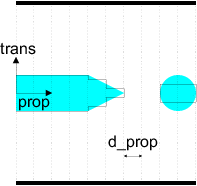
| [ < ] | [ > ] | [ << ] | [ Up ] | [ >> ] | [Top] | [Contents] | [Index] | [ ? ] |
CAMFR has a facility which makes it easier to define complicated non-trivial structures. Rather than manually specifying the geometry slice by slice, we can define a 2D structure in terms of higher level geometric shapes, like circles, triangles or rectangles. This definition can then be automatically discretised and converted to an expression which can be used to initialise a stack.
To illustrate this, we model the structure from Fig. 2.5.
#!/usr/bin/env python
####################################################################
#
# Illustrates how to define complicated structures using Geometry.
#
####################################################################
from camfr import *
set_lambda(1)
set_N(40)
air = Material(1)
mat = Material(3)
g = Geometry(air)
g += Rectangle(Point(0.0,-0.5), Point(2.0, 0.5), mat)
g += Triangle (Point(2.0, 0.5), Point(2.0,-0.5), Point(3.0, 0.0), mat)
g += Circle (Point(4.5, 0.0), 0.5, mat)
set_lower_PML(-0.1)
set_upper_PML(-0.1)
prop0, prop1, d_prop = 0.0, 5.0, 0.50
trans0, trans1, d_trans = -2.5, 2.5, 0.01
exp = g.to_expression(prop0, prop1, d_prop,
trans0, trans1, d_trans)
s = Stack(exp)
s.calc()
print s.R12(0,0)
|

The command g = Geometry(air) creates a Geometry object with
air as background material. We can subsequently add shapes to this object,
e.g. g += Rectangle(Point(0.0,-0.5), Point(2.0, 0.5), mat) adds a
rectangle consisting of material mat with given lower left and
top right vertices. Note that the first coordinate refers the propagation
direction (horizontal in the case of Fig. 2.5).
Other shapes we can add are Circle, Triangle or Square.
If two shapes overlap, the shape that was added last takes precedence.
Finally, we can convert the geometry object to an expression which can be
used to create a stack. The arguments to this to_expression function
are the range and precision in both the propagation and transverse direction
(see Fig 2.5).
The increments d_prop and d_trans deserve some additional
explanation, because they don't correspond to a uniform rectangular grid. The
way the discretisation in performed is as follows. First, the structure is
split up into a number of slices in the propagation direction, each
d_prop long. Then, subsequent slices are combined if the material
discontinuities in the transverse direction are no more than d_trans
apart.. This creates some kind of dynamic resolution, because in regions
where the shapes vary slower, we will have fewer (but thicker) slices.
Also, it makes sure that subsequent identical slices are always combined
into one slab. All of this makes for a more efficient discretisation than
a traditional uniform grid.
Finally, we want to point out that it's quite easy for the user to add
custom shapes by defining a Python object which overloads
intersection_at_x. See camfr/geometry.py for more details.
| [ < ] | [ > ] | [ << ] | [ Up ] | [ >> ] |
This document was generated by root on August, 27 2008 using texi2html 1.76.